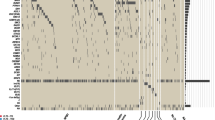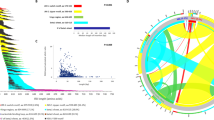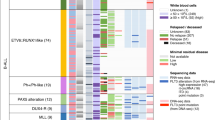Abstract
Somatic mutations of FLT3 resulting in constitutive kinase activation are the most common acquired genomic abnormality found in acute myeloid leukemia (AML). The majority of these mutations are internal tandem duplications (ITD) of the juxtamembrane region (JM). In addition, a minority of cases of AML are associated with mutation of the FLT3 activation loop (AL), typically involving codons D835 and/or I836. We hypothesized that other novel mutations of FLT3 could also contribute to leukemogenesis. We genotyped 109 cases of AML and identified two novel gain-of-function mutations. The first mutation, N841 H, is similar to previously described mutations involving amino-acid substitutions of codon 841. The other novel mutation, FLT3 K663Q, is the first AML-associated gain-of-function mutation located outside the JM and AL domains. Of note, this mutation was potently inhibited by Sunitinib (SU11248), a previously described FLT3 kinase inhibitor. Sunitinib reduced the proliferation and induced apoptosis of transformed Ba/F3 cells expressing FLT3 K663Q. The potency of Sunitinib against FLT3 K663Q was similar to its potency against FLT3 ITD mutations. We conclude that FLT3 mutations in AML can involve novel regions of the TK1. Future studies are needed to define the incidence and prognostic significance of FLT3 mutations outside the well-established JM and AL regions.
This is a preview of subscription content, access via your institution
Access options
Subscribe to this journal
Receive 12 print issues and online access
We are sorry, but there is no personal subscription option available for your country.
Buy this article
- Purchase on SpringerLink
- Instant access to full article PDF
Prices may be subject to local taxes which are calculated during checkout






Similar content being viewed by others
References
Baldus CD, Thiede C, Soucek S, Bloomfield CD, Thiel E, Ehninger G . BAALC expression and FLT3 internal tandem duplication mutations in acute myeloid leukemia patients with normal cytogenetics: prognostic implications. J Clin Oncol 2006; 24: 790–797.
Schnittger S, Schoch C, Dugas M, Kern W, Staib P, Wuchter C et al. Analysis of FLT3 length mutations in 1003 patients with acute myeloid leukemia: correlation to cytogenetics, FAB subtype, and prognosis in the AMLCG study and usefulness as a marker for the detection of minimal residual disease. Blood 2002; 100: 59–66.
Kottaridis PD, Gale RE, Frew ME, Harrison G, Langabeer SE, Belton AA et al. The presence of a FLT3 internal tandem duplication in patients with acute myeloid leukemia (AML) adds important prognostic information to cytogenetic risk group and response to the first cycle of chemotherapy: analysis of 854 patients from the United Kingdom Medical Research Council AML 10 and 12 trials. Blood 2001; 98: 1752–1759.
Thiede C, Steudel C, Mohr B, Schaich M, Schakel U, Platzbecker U et al. Analysis of FLT3-activating mutations in 979 patients with acute myelogenous leukemia: association with FAB subtypes and identification of subgroups with poor prognosis. Blood 2002; 99: 4326–4335.
Mizuki M, Fenski R, Halfter H, Matsumura I, Schmidt R, Muller C et al. Flt3 mutations from patients with acute myeloid leukemia induce transformation of 32D cells mediated by the Ras and STAT5 pathways. Blood 2000; 96: 3907–3914.
Tse KF, Mukherjee G, Small D . Constitutive activation of FLT3 stimulates multiple intracellular signal transducers and results in transformation. Leukemia 2000; 14: 1766–1776.
Fenski R, Flesch K, Serve S, Mizuki M, Oelmann E, Kratz-Albers K et al. Constitutive activation of FLT3 in acute myeloid leukaemia and its consequences for growth of 32D cells. Br J Haematol 2000; 108 (2): 322–330.
Heinrich MC, Rubin BP, Longley BJ, Fletcher JA . Biology and genetic aspects of gastrointestinal stromal tumors: KIT activation and cytogenetic alterations. Hum Pathol 2002; 33: 484–495.
Kemmer K, Corless CL, Fletcher JA, McGreevey L, Haley A, Griffith D et al. KIT mutations are common in testicular seminomas. Am J Pathol 2004; 164: 305–313.
Zermati Y, De Sepulveda P, Feger F, Letard S, Kersual J, Casteran N et al. Effect of tyrosine kinase inhibitor STI571 on the kinase activity of wild-type and various mutated c-kit receptors found in mast cell neoplasms. Oncogene 2003; 22: 660–664.
O'Farrell AM, Abrams TJ, Yuen HA, Ngai TJ, Louie SG, Yee KW et al. is a novel FLT3 tyrosine kinase inhibitor with potent activity in vitro and in vivo. Blood 2003; 101: 3597–3605.
Yee KW, Schittenhelm M, O'farrell AM, Town AR, McGreevey L, Bainbridge T et al. Synergistic effect of SU11248 with cytarabine or daunorubicin on FLT3 ITD-positive leukemic cells. Blood 2004; 104: 4202–4209.
Yee KW, O'Farrell AM, Smolich BD, Cherrington JM, McMahon G, Wait CL et al. SU5416 and SU5614 inhibit kinase activity of wild-type and mutant FLT3 receptor tyrosine kinase. Blood 2002; 100: 2941–2949.
Rader AE, Avery A, Wait CL, McGreevey LS, Faigel D, Heinrich MC . Fine-needle aspiration biopsy diagnosis of gastrointestinal stromal tumors using morphology, immunocytochemistry, and mutational analysis of c-kit. Cancer 2001; 93: 269–275.
Choy YS, Dabora SL, Hall F, Ramesh V, Niida Y, Franz D et al. Superiority of denaturing high performance liquid chromatography over single-stranded conformation and conformation-sensitive gel electrophoresis for mutation detection in TSC2. Ann Hum Genet 1999; 63 (Part 5): 383–391.
Hoatlin ME, Christianson TA, Keeble WW, Hammond AT, Zhi Y, Heinrich MC et al. The Fanconi anemia group C gene product is located in both the nucleus and cytoplasm of human cells. Blood 1998; 91: 1418–1425.
Heinrich MC, Griffith DJ, Druker BJ, Wait CL, Ott KA, Zigler AJ . Inhibition of c-kit receptor tyrosine kinase activity by STI 571, a selective tyrosine kinase inhibitor. Blood 2000; 96: 925–932.
Brown P, Small D . FLT3 inhibitors: a paradigm for the development of _targeted therapeutics for paediatric cancer. Eur J Cancer 2004; 40: 707–721, discussion.
Jiang J, Paez JG, Lee JC, Bo R, Stone RM, DeAngelo DJ et al. Identifying and characterizing a novel activating mutation of the FLT3 tyrosine kinase in AML. Blood 2004; 104: 1855–1858.
Lux ML, Rubin BP, Biase TL, Chen CJ, Maclure T, Demetri G et al. KIT extracellular and kinase domain mutations in gastrointestinal stromal tumors. Am J Pathol 2000; 156: 791–795.
Heinrich MC, Corless CL, Demetri GD, Blanke CD, von Mehren M, Joensuu H et al. Kinase mutations and imatinib response in patients with metastatic gastrointestinal stromal tumor. J Clin Oncol 2003; 21: 4342–4349.
Hayakawa F, Towatari M, Kiyoi H, Tanimoto M, Kitamura T, Saito H et al. Tandem-duplicated Flt3 constitutively activates STAT5 and MAP kinase and introduces autonomous cell growth in IL-3-dependent cell lines. Oncogene 2000; 19: 624–631.
Brown P, Meshinchi S, Levis M, Alonzo TA, Gerbing R, Lange B et al. Pediatric AML primary samples with FLT3/ITD mutations are preferentially killed by FLT3 inhibition. Blood 2004; 104: 1841–1849.
Ciolli S, Vannucchi AM, Leoni F, Nozzoli C, Longo G, Salati A et al. Internal tandem duplications of Flt3 gene (Flt3/ITD) predicts a poor post-remission outcome in adult patients with acute non-promyelocytic leukemia. Leuk Lymphoma 2004; 45: 73–78.
Whitman SP, Archer KJ, Feng L, Baldus C, Becknell B, Carlson BD et al. Absence of the wild-type allele predicts poor prognosis in adult de novo acute myeloid leukemia with normal cytogenetics and the internal tandem duplication of FLT3: a cancer and leukemia group B study. Cancer Res 2001; 61: 7233–7239.
Gilliland DG . Hematologic malignancies. Curr Opin Hematol 2001; 8: 189–191.
Kelly LM, Liu Q, Kutok JL, Williams IR, Boulton CL, Gilliland DG . FLT3 internal tandem duplication mutations associated with human acute myeloid leukemias induce myeloproliferative disease in a murine bone marrow transplant model. Blood 2002; 99: 310–318.
Kelly LM, Kutok JL, Williams IR, Boulton CL, Amaral SM, Curley DP et al. PML/RARalpha and FLT3-ITD induce an APL-like disease in a mouse model. Proc Natl Acad Sci USA 2002; 99: 8283–8288.
Heinrich MC, Corless CL, Duensing A, McGreevey L, Chen CJ, Joseph N et al. PDGFRA activating mutations in gastrointestinal stromal tumors. Science 2003; 299: 708–710.
Care RS, Valk PJ, Goodeve AC, Abu-Duhier FM, Geertsma-Kleinekoort WM, Wilson GA et al. Incidence and prognosis of c-KIT and FLT3 mutations in core binding factor (CBF) acute myeloid leukaemias. Br J Haematol 2003; 121: 775–777.
Subramanian S, West RB, Corless CL, Ou W, Rubin BP, Chu KM et al. Gastrointestinal stromal tumors (GISTs) with KIT and PDGFRA mutations have distinct gene expression profiles. Oncogene 2004; 23: 7780–7790.
Reindl C, Bagrintseva K, Vempati S, Schnittger S, Ellwart JW, Wenig K et al. Point mutations found in the juxtamembrane domain of FLT3 define a new class of activating mutations in AML. Blood 2006; 107: 3700–3707.
Kindler T, Breitenbuecher F, Kasper S, Estey E, Giles F, Feldman E et al. Identification of a novel activating mutation (Y842C) within the activation loop of FLT3 in patients with acute myeloid leukemia (AML). Blood 2005; 105: 335–340.
Piccaluga PP, Bianchini M, Martinelli G . Novel FLT3 point mutation in acute myeloid leukaemia. Lancet Oncol 2003; 4: 604.
O'Farrell AM, Foran JM, Fiedler W, Serve H, Paquette RL, Cooper MA et al. An innovative phase I clinical study demonstrates inhibition of FLT3 phosphorylation by SUNITINIBin acute myeloid leukemia patients. Clin Cancer Res 2003; 9: 5465–5476.
Griswold IJ, Shen LJ, La Rosee P, Demehri S, Heinrich MC, Braziel RM et al. Effects of MLN518, a dual FLT3 and KIT inhibitor, on normal and malignant hematopoiesis. Blood 2004; 104: 2912–2918.
Fiedler W, Mesters R, Tinnefeld H, Loges S, Staib P, Duhrsen U et al. A phase 2 clinical study of SU5416 in patients with refractory acute myeloid leukemia. Blood 2003; 102: 2763–2767.
Fiedler W, Serve H, Dohner H, Schwittay M, Ottmann OG, O'Farrell AM et al. A phase 1 study of SU11248 in the treatment of patients with refractory or resistant acute myeloid leukemia (AML) or not amenable to conventional therapy for the disease. Blood 2005; 105: 986–993.
Levis M, Pham R, Smith BD, Small D . In vitro studies of a FM inhibitor combined with chemotherapy: sequence of administration is important to achieve synergistic cytotoxic effects. Blood 2004; 104: 1145–1150.
Heidel F, Solem FK, Breitenbuecher F, Lipka DB, Kasper S, Thiede MH et al. Clinical resistance to the kinase inhibitor PKC412 in acute myeloid leukemia by mutation of Asn-676 in the FLT3 tyrosine kinase domain. Blood 2006; 107: 293–300.
Clark JJ, Cools J, Curley DP, Yu JC, Lokker NA, Giese NA et al. Variable sensitivity of FLT3 activation loop mutations to the small molecule tyrosine kinase inhibitor MLN518. Blood 2004; 104: 2867–2872.
Acknowledgements
Flow cytometry support was provided by the Flow Cytometry Shared Resource of the OHSU Cancer Institute (P30 CA69533). This was supported in part by a Merit Review Grant from the Department of Veterans Affairs (MCH), the Doris Duke Charitable Foundation (MCH&KWHY), the Leukemia and Lymphoma Society (MCH), an NIH Cancer Biology Training Grant (JWT, Award number 5-T32-CA101690-03), the Deutsche Krebshilfe Foundation (MMS) and the fortüne-Program of the University of Tübingen (1490-0-0) (MMS). Several of the authors (A-MO, JMC) were employed by a company (SUGEN Inc.) whose product was studied in the present work.
Author information
Authors and Affiliations
Corresponding author
Rights and permissions
About this article
Cite this article
Schittenhelm, M., Yee, K., Tyner, J. et al. FLT3 K663Q is a novel AML-associated oncogenic kinase: determination of biochemical properties and sensitivity to Sunitinib (SU11248). Leukemia 20, 2008–2014 (2006). https://doi.org/10.1038/sj.leu.2404374
Received:
Revised:
Accepted:
Published:
Issue Date:
DOI: https://doi.org/10.1038/sj.leu.2404374
Keywords
This article is cited by
-
Characterisation of FLT3 alterations in childhood acute lymphoblastic leukaemia
British Journal of Cancer (2024)
-
Diagnostic and therapeutic pitfalls in NPM1-mutated AML: notes from the field
Leukemia (2021)
-
Homology modeling of DFG-in FMS-like tyrosine kinase 3 (FLT3) and structure-based virtual screening for inhibitor identification
Scientific Reports (2015)
-
Quizartinib (AC220) is a potent second generation class III tyrosine kinase inhibitor that displays a distinct inhibition profile against mutant-FLT3, -PDGFRA and -KIT isoforms
Molecular Cancer (2013)
-
Cell cycle-dependent activity of the novel dual PI3K-MTORC1/2 inhibitor NVP-BGT226 in acute leukemia
Molecular Cancer (2013)



